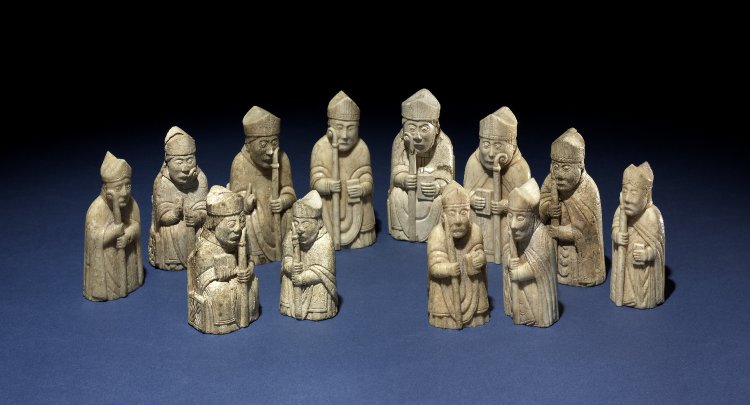
The Lewis Chessman, c. 1150-1175 CE. The British Museum.
The Lewis Chessmen are one of the most famous sets of chess pieces in the world. Prominently displayed at The British Museum and the National Museum of Scotland, these pieces have been publicized as being made in Norway by men.
But that’s probably not the truth.
The Lewis Chessmen are 93 gaming pieces found in the vicinity of Uig on the Isle of Lewis around 1831. The pieces include 78 chessmen, 14 tables-men, and a buckle to secure a bag. All are made of elaborately worked walrus ivory and whale teeth to form the shapes of kings, queens, bishops, knights on their mounts, standing warders, and pawns. Most scholars estimate that the find is actually four or more chess sets, though no one knows for sure.
Together, they represent a late Norse army – including the mix of queens, Christian bishops, and Viking berserks (or “shield-biters”) known at the time throughout Norse countries. Yet analyzing all the evidence, historian Nancy Marie Brown recently published a book that refutes traditional ideas about where the chessmen came from – and who they were made by.
The new theory, based on recently translated Norse sagas, posits that the Lewis Chessmen were made by a woman, Margaret the Adroit.
Margaret lived in Skaholt, Iceland, during the late twelfth century. She was hired by Bishop Pall Jonsson to carve gifts for his colleagues in Denmark, Norway, Scotland, and Greenland – a tradition of gift-giving that was widespread. This was because Iceland was at the height of its golden age; as a rich, independent country, it was full of artistic creation and widely connected to Europe and beyond. It was an unprecedented time for the exchange of ideas, so much that it’s difficult to tell what art comes from where. Artists were known to travel widely and learn from one another, creating a cross-cultural artistic exchange that influenced the whole of Europe.
Margaret was one such artist. In the Saga of Bishop Pall, she is credited with carving “a bishop’s crozier of walrus ivory, carved so skillfully that no one in Iceland had ever seen such artistry before; it was made by Margaret the Adroit, who at that time was the most skilled carver in all Iceland.” We know that the Saga itself is true – archaeologists have found the sarcophagus of Bishop Pall, exactly as it is described in the Saga, and he was holding a crozier that matched the description of Margaret’s work. So we can assume that Margaret was real, too – and we know that she lived and worked in Skalholt, making “everything that Bishop Pall wanted” in wood and ivory.
Yet despite all the evidence, many scholars still assume – based on scant evidence – that the chessmen were made in Norway by a man, or by several men. Yet Nancy’s book shows, through various types of evidence, that it’s more likely the chessmen were made in Iceland by Margaret – or, at least, by those in her workshop. They may have even been made over a long period of time – showing variation and stylistic similarity that suggests Margaret may have made them as she slowly developed her craft. The faces may even reflect ones that Margaret knew in real life.
Like much of history, Margaret’s story is highly debated. No one knows for sure, because no archaeologists have yet excavated twelfth-century Skaholt, where Margaret lived and worked, or Uig on the Isle of Lewis where the chessmen were found. Both locations were notable during Margaret’s lifetime – Skaholt as the bishop’s seat, and Lewis as an administrative center in Iceland with thriving international ties. Unless we go looking for the evidence that Nancy and others believe may be there, we’ll never know for sure.
But we do know that Margaret and Bishop Pall lived. That they loved art. And that Margaret had the skill and renown in her craft to be charged to create these fascinating chessmen.
-Tiffany Rhoades
Program Developer
Girl Museum Inc.
This post is part of our 52 Objects in the History of Girlhood exhibition. Each week during 2017, we explore a historical object and its relation to girls’ history. Stay tuned to discover the incredible history of girls, and be sure to visit the complete exhibition to discover the integral role girls have played since the dawn of time.
